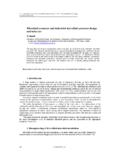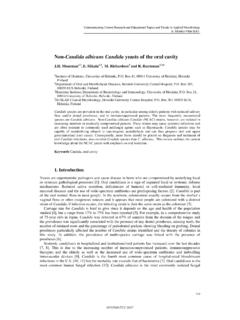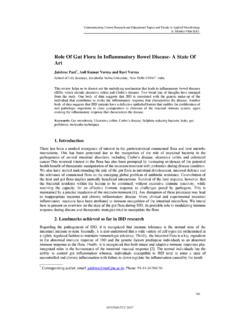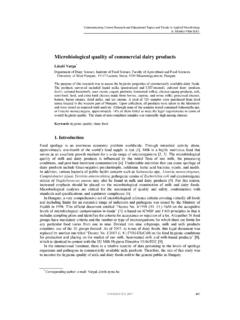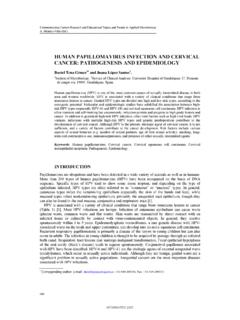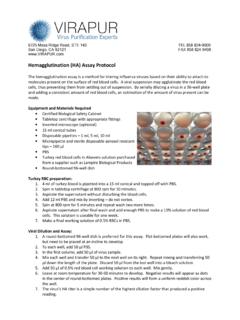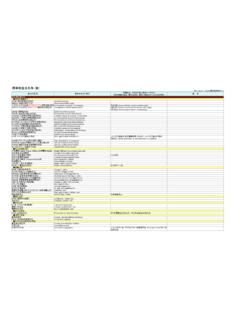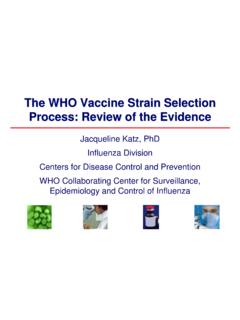Transcription of Identification and characterization of influenza virus ...
1 Identification and characterization of influenza virus isolated from Brazilian snakes D. A. P. Mancini1, R. M. Z Mendon a1, Kawamoto1, M. Giorgetti1, H. G. Trindade1, W. Fernandes2, K. F. Grego2, Antoniazzi3, C. Jared3, Pinto1 1-Laboratory of Virology - Butantan Institute Avda: Vital Brasil, 1500, Zip code: 05503-900, S o Paulo, (SP) Brazil e-mail: 2-Laboratory of Herpetology - Butantan Institute Avda: Vital Brasil, 1500, Zip code: 05503-900, S o Paulo, (SP) Brazil 3-Laboratory of Cellular Biology Butantan Institute Avda: Vital Brasil, 1500, Zip code.
2 05503-900, S o Paulo, (SP) Brazil It has been reported that the reptilians can harbor pathogenic microorganisms asymptomatically and serve as potential reservoir of infection to humans, domestic animals and other reptilians. In this present study the aims was to search for an influenza virus in unknown hosts, among the heterothermic animals. Using samples collected from diseased snakes belonging to both genuses: Bothrops and Crotalus, kept in captivity at the Butantan Institute, Brazil, methodology was used for isolation, Identification and characterization of the influenza virus .
3 Several repetitions of the snakes pulmonary washings was done with MDCK cells, observing the cytopathic effects (CPE) fluids harvested were evaluated by a hemagglutination test (HA) and Serological tests such as the influenza Rapid Test ( Gloria) and hemagglutination Inhibition (HI) using antibody anti- influenza A and B types patterns. The characterization of influenza isolates it was performed by the RT/PCR techniques, with primer PcDNA(flu) that amplifly a 189 bp fragment of NS1 gene.
4 Electron Microscopy (EM) was employed to observe the viral particle ultrastructure. Results obtained through those methods showed that virus replicated in MDCK, showing CPE, with mean titer of 60 HAU was comparable with the influenza virus . This virus Identification was verified by the antibody to influenza viruses A and B patterns which recognized the antigen of the isolates, by both the Gloria and HI tests . The PCR product characterized the isolates as an the influenza virus that was compatible with the influenza virus used as control.
5 Positive samples observed in EM revealed particles measuring 40 to 120 nm, with an envelope surrounded by spikes. These particles were similar to the human influenza virus on these data and also considering the fact that these snakes had respiratory symptoms, it is possible to conclude that these animals could be a susceptible host and a harbour to the influenza virus . The present unpublished work was performed to collaborate with the global search for the influenza host circulation. Keywords: Snakes; influenza virus ; Isolation; Identification .
6 Introduction Respiratory diseases in snakes are complex, because if they are not immunocompetent to the infectious agents that are exposed, certainly these animals will have to confront a battle. The major cause of the snakes morbility is related to respiratory disease provoked by viruses. The viruses that are most cited belong to the Paramyxoviridae. Within this virus family, the Paramyxovirus as Parainfluenza III, Senday virus , as well the Mumps and Measles virus are the most frequent isolates from the different species of snakes.
7 It has been also reported that the reptilians can harbor pathogenic microorganism asymptomatically and serve as potential reservoirs of infection to humans, domestic animals and other reptilians.[1,2] By the phylogenetic analyses, the ophidian Paramyxovirus identified by its nucleotide sequences, could be a factor for proposing a new genus for reptilian Paramyxovirus within the Paramyxoviridae. 868 Communicating Current Research and Educational Topics and Trends in Applied Microbiology A. M ndez-Vilas (Ed.)
8 _____ FORMATEX 2007 This is because of the divergence observed in these virus antigens, and particularly the low homoly of the available sequences. [3,4,5] In our previous work with heterothermic animals, such as snakes (genus Bothrops and genus Crotalus) and toads and frogs (genuses Bufo and Rana) all animals investigated were shown to have receptors in theirs red cells and antibodies specific to the influenza virus .[6] The importance of investigating the unknown hosts of the influenza virus is the consideration of its recombinant feature that occurs, during the process of viral transmission, between both animals and humans.
9 This present work aimed the isolation, Identification and characterization of the influenza virus in two differents genuses of snakes, the Crotalus durissus terrificus and Bothrops neuwiedi. Material and methods Viral strains Pattern influenza virus - supplied by Bethesda (USA)Type A: A/Chile/1/83 (H1N1) (ANT#12) and A/Philippine/2/82 (H3N2) (ANT#11X79). Type B: B/USSR/100/83 (ANT#13). Anti-sera Pattern Anti-sera to influenza supplied by Bethesda (USA): Anti-A Ref: S-22 L-2 A/Chile/1/83 (H1N1) and Ref: S1670 A/Philippine/2/82 (H3N2); Anti-B Ref: S-26 B/URSS/100/83.
10 Animals [6] Tree adult snakes: Bothrops neuwiedi (a and b) and Crotalus durissus terrificus(c) belong to Herpetology Department at Butantan Institute, S o Paulo, Brazil, were used. The respiratory disease symptoms were present in both genuses. Samples of sera [6] The samples were harvested by the tail vein of the snakes using disposable needles: 25X7mm. After blood coagulation and retraction, the serum was removed and kept at 70 C until the time came to perform the serologic test. virus isolation [7] The snakes washing pulmonary samples were inoculated in monolayers of MDCK, NCI-H292 and VERO cells.
